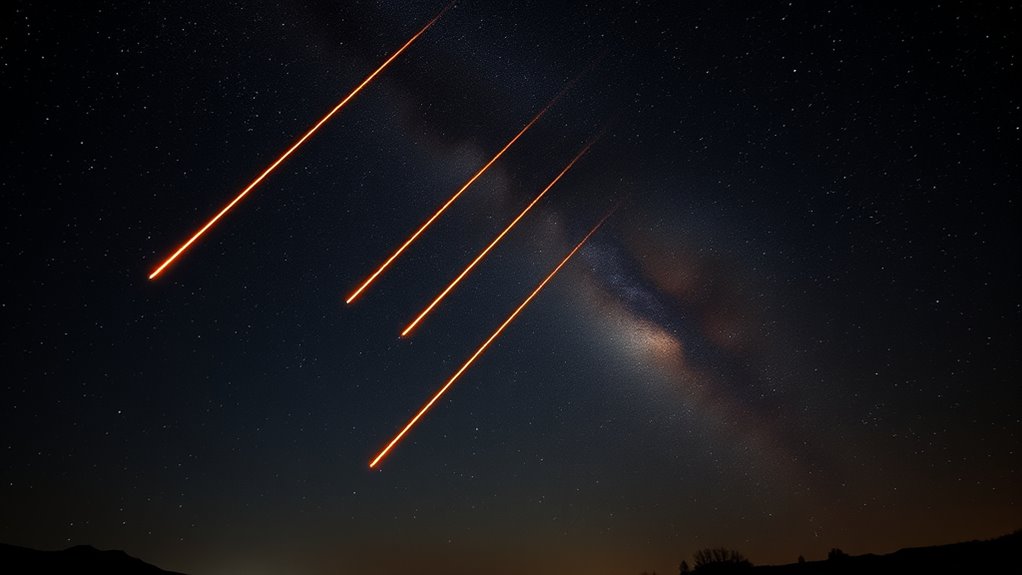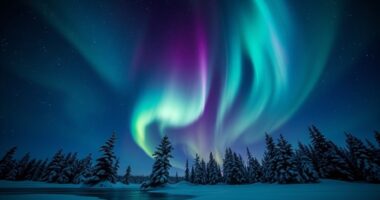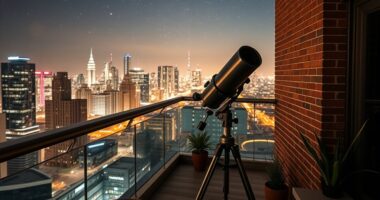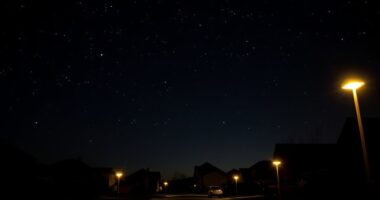You can enjoy five spectacular meteor showers without a telescope: the Perseids in August, known for bright streaks; the Geminids in December, with many fireballs; the Quadrantids in January, active early in the year; the Lyrids in April, offering swift meteors; and the Eta Aquarids in May, visible in spring. All these events are best viewed in dark skies away from city lights, and there’s more to discover about when and where to watch for the best experience.
Key Takeaways
- The Perseids peak around August 12, offering a spectacular summer show best viewed in dark, rural northern hemisphere locations.
- The Geminids peak in mid-December and are visible from mid-December to early January, with high activity in the constellation Gemini.
- The Quadrantids occur in early January, providing intense fireball displays from a dark spot between midnight and dawn.
- The Lyrids peak around April 22, best seen after midnight in dark, rural areas during a new moon phase.
- The Eta Aquarids, peaking in early May, are visible from late April to early May, appearing to radiate from Aquarius in dark skies.
Perseids Meteor Shower
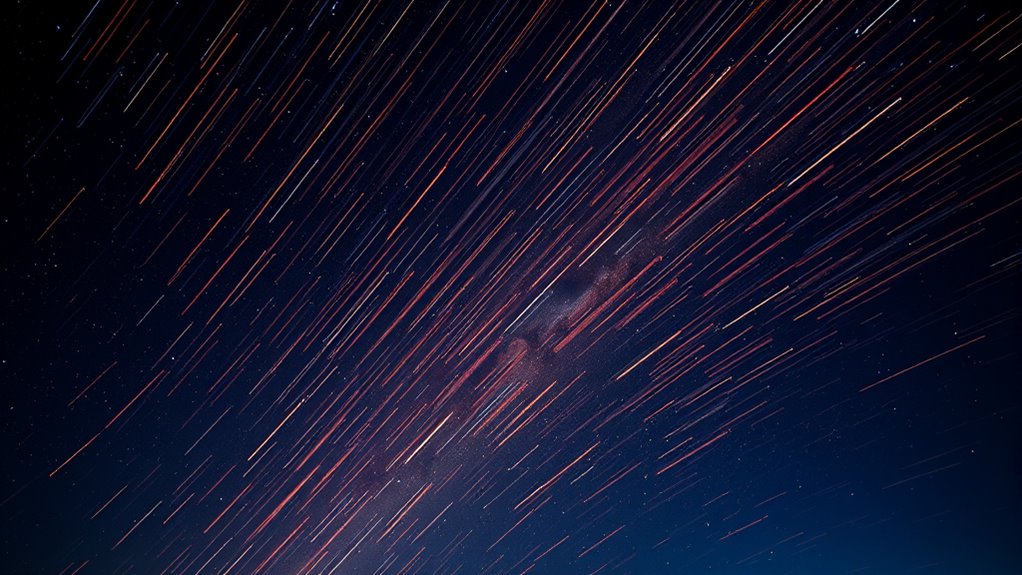
The Perseids Meteor Shower is one of the most popular and spectacular celestial events of the year. If you’re in the northern hemisphere, you’ll find the best viewing typically between mid-July and late August. To maximize your experience, plan to watch during the shower’s peak, usually around August 12th. Keep in mind, the moon phase impacts visibility; a new moon offers dark skies perfect for seeing more meteors, while a bright moon can wash out fainter ones. Check the lunar calendar and aim for nights when the moon is minimal or below the horizon. Find a dark, open spot away from city lights, look up, and enjoy the shower’s breathtaking display of streaking meteors across the night sky. Proper tuning of your equipment or gear can enhance your viewing experience, ensuring clear skies and comfortable conditions for stargazing.
Geminids Meteor Shower

Building on the excitement of the Perseids, the Geminids Meteor Shower offers another spectacular opportunity to witness shooting stars. Originating from asteroid 3200 Phaethon, this meteor shower peaks in mid-December, providing a winter spectacle. To get the best viewing experience, keep these practices in mind:
- Find a dark, rural location away from city lights.
- Watch after midnight when meteors are most active.
- Allow your eyes time to adjust to darkness—about 20 minutes.
- Look towards the constellation Gemini, where the meteors appear to radiate.
Additionally, preparing a comfortable remote work environment can enhance your overall experience by allowing you to relax and enjoy the night sky without distractions.
Quadrantids Meteor Shower
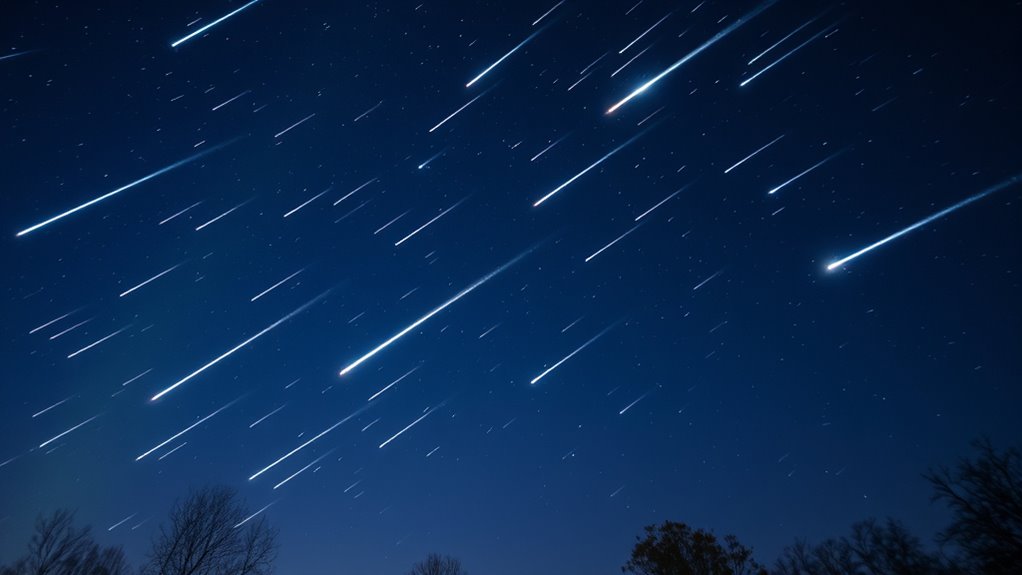
Prepare to catch one of the year’s most intense meteor showers, as the Quadrantids light up the night sky each January. During this event, you might see a higher fireball frequency than usual, making it especially exciting for skywatchers. The meteors appear to radiate from the constellation Boötes, but you don’t need to aim directly at it; just look up. The ideal viewing times are usually between midnight and dawn when the sky is darkest. The Quadrantids are known for their sharp peak, often lasting just a few hours, so planning your viewing window is key. Find a dark spot away from city lights, lie back, and enjoy the brilliant streaks crossing the sky. This meteor shower offers a spectacular show with minimal equipment needed. Adequate sky visibility is essential for the best experience, so check the weather forecast beforehand.
Lyrids Meteor Shower
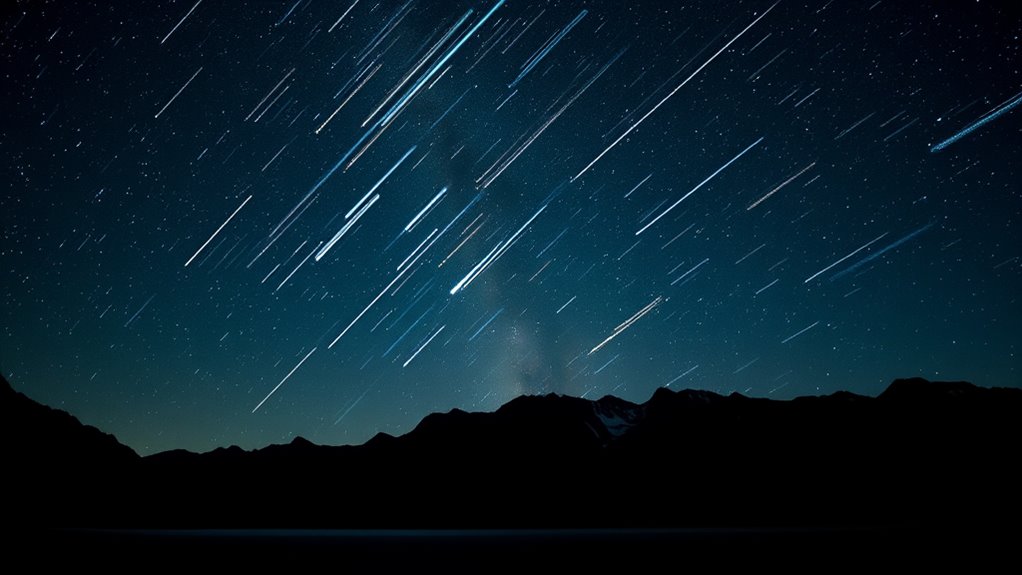
Have you ever wondered when to catch the breathtaking Lyrids Meteor Shower? It peaks around April 22 each year, offering a spectacular sky show. If you’re in the northern hemisphere, you’ll have the best viewing opportunities, especially after midnight when the sky is darker. Keep in mind that the moon phase impacts visibility: a new moon provides ideal conditions, while a full moon can wash out many meteors. To maximize your experience:
- Check the peak date and time.
- Find a dark, rural location away from city lights.
- Watch after midnight when meteors are most active.
- Prepare warm clothing and a comfortable chair.
Eta Aquarids Meteor Shower

Ever wondered when to catch the dazzling Eta Aquarids Meteor Shower? This spectacular event peaks in early May, offering great skywatching opportunities. To make the most of it, check the meteor shower timing—usually between late April and early May, with peak activity around May 5-6. Find a dark, clear spot away from city lights and give your eyes time to adjust. Lie back comfortably and look toward the constellation Aquarius, where the meteors seem to originate. Remember, no telescope needed; just your eyes and patience. Keep an eye on weather forecasts and moon phases, as bright moonlight can obscure the view. Proper skywatching techniques can enhance your experience and increase your chances of catching the meteors’ swift, glowing streaks across the night sky.
Frequently Asked Questions
What Is the Best Time of Night to View Meteor Showers?
The best time of night to view meteor showers is usually after midnight, when the sky is darkest. Avoid moonlight, so check the moon phase—new moon nights offer the best viewing. Also, find a spot away from light pollution to increase your chances of catching those streaks across the sky. Stay patient, look up, and you’ll enjoy a spectacular display even without a telescope.
How Often Do Meteor Showers Occur Each Year?
Meteor showers happen several times a year, but their frequency patterns vary. You can expect about 2 to 4 major meteor showers annually, with some minor ones scattered throughout the year. Annual variations occur due to Earth’s orbit and the position relative to debris streams from comets and asteroids. So, if you stay alert, you’ll have plenty of chances to enjoy these celestial displays without needing a telescope.
Are Meteor Showers Visible From Both Hemispheres?
Imagine witnessing a celestial ballet that spans the entire sky—yes, meteor showers are visible from both hemispheres! Hemisphere visibility depends on your location and the shower’s radiant point, making polar viewing possible at certain times. While some showers are best seen from specific regions, most are accessible to skywatchers worldwide, offering breathtaking displays that defy geographic boundaries and illuminate the night regardless of where you stand.
What Equipment, Besides a Telescope, Can Enhance Viewing?
You don’t need a telescope to enjoy meteor showers, but binoculars can help you see more stars and faint meteors. Using star charts guides you to the best viewing spots and times. Find a dark, open area away from city lights, and give your eyes time to adjust. With binoculars and star charts, you’ll enhance your experience and catch even more dazzling meteors during peak activity.
Can Meteor Showers Be Seen During Cloudy or Rainy Nights?
Imagine you’re eager to watch a meteor shower, but cloud cover and poor weather conditions block your view. Unfortunately, on cloudy or rainy nights, meteor showers are usually hidden from sight because the clouds obstruct the sky. Unless you have access to a telescope or other technology that can see through clouds, you’ll need clear skies for the best viewing experience. Weather conditions play a vital role in your meteor shower viewing success.
Conclusion
Now that you know these five spectacular meteor showers, you’re ready to chase the night’s fireworks. Each shower is like a fleeting brushstroke on a cosmic canvas, offering a mesmerizing display for free. So, mark your calendar, find a dark spot, and look up. With patience, you’ll witness the sky’s own fireworks show — a luminous ballet that reminds us how vast and wondrous the universe truly is.
